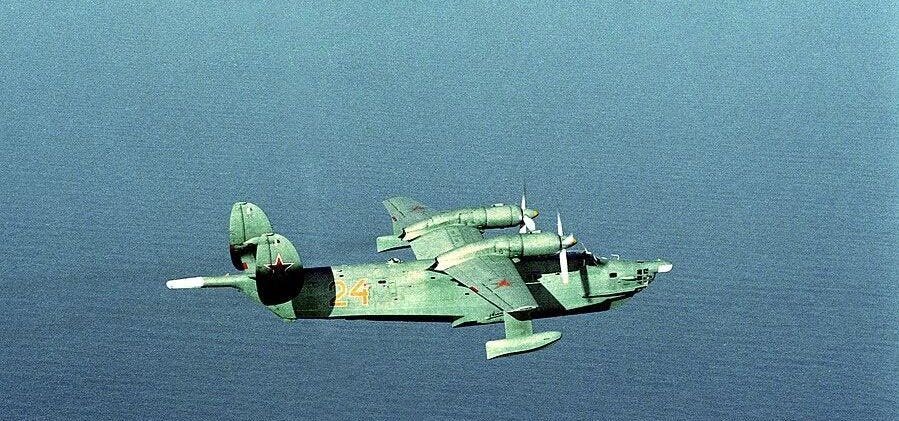Targeted by cruise missiles, harried by explosives-laden drone boats and anticipating future assaults by drone submarines, the beleaguered Russian Black Sea Fleet is mobilizing every naval patrol asset it has.
Including some very old Beriev Be-12 seaplanes.
“In recent weeks, the naval aviation component of Russia’s Black Sea Fleet has assumed a particularly important role in the fleet’s operations as it struggles to deal with concurrent threats on the southern flank of the Ukraine war,” the U.K. defense ministry reported on Monday.
“The early identification of uncrewed surface vessels” is the component’s “primary mission,” the ministry added. “A key Russian asset in these operations is the Be-12 … amphibious aircraft, designed in the 1950s [and built a decade later], flying out of bases in occupied Crimea.”
Three of the twin-engine Berievs, none younger than 50 years, might still lumber around the Black Sea on patrol and rescue missions. Russian naval aviation reportedly operates three additional Be-12s as part of other regional fleets.
Beriev sightings are rare. So it was news when one of the distinctive, gull-wing seaplanes appeared in commercial satellite imagery of Saki air base, on Crimea’s west coast, in the days following a Ukrainian attack on the base on Aug. 9, 2022.
That attack, apparently carried out by drones or ballistic missiles, damaged or destroyed several Russian navy warplanes on the ground at Saki.
But it seems a Be-12 that was at Saki at the time of the Ukrainian bombardment escaped harm. In satellite imagery from the raid’s aftermath, the seaplane sits in a revetement a short distance from the apron where most of the damage occurred.
The 32-ton Beriev seaplane entered service with the Soviet fleet back in the 1960s. With its 330-mile-per-hour top speed, seven-ton payload and ability to land on water, it flew patrol and rescue missions—and was a modest export success.
The Ukrainian navy inherited seven Be-12s when the Soviet Union collapsed in 1991. They flew from Saki back when Crimea still was under Ukrainian control. When the Russians invaded Crimea in February 2014, one Ukrainian Be-12 managed to get off the ground and escape to Mykolaiv in southern Ukraine.
The Russians captured the other Beriev airframes. Weirdly, they actually returned to the Ukrainians many of the planes they captured in Crimea—including the Be-12 with the code Yellow 02.
In April 2014, Russian troops on the peninsula allowed a Ukrainian crew to fly Yellow 02 to Mykolayiv. Two years later, that seaplane took part in Sea Breeze 2014, a NATO war game on the Black Sea.
Both surviving Ukrainian Be-12s flew until at least 2019, but in recent photos—including a pair from late 2021—the seaplanes appear to be in poor repair, and possibly grounded.
That makes sense, as the Black Sea has become a very dangerous place—especially for Ukrainian aircraft, and doubly so for slow Ukrainian aircraft.
Keeping up a couple of ancient seaplanes surely is a low priority for the Ukrainian navy, which no longer has any large armed warships and mostly fights with land-based anti-ship missiles, aerial drones, drone boats and—soon—drone submarines.
The air-defense situation over the sea is somewhat more favorable for Russian aircraft, which at least enjoy some protection from the surviving S-400 surface-to-air missile batteries in Crimea. Of course, that might change as the Ukrainians continue targeting Russian air-defenses on the peninsula.
Whether the seaplane that was at Saki in August last year is flyable, or has been flyable in recent years, is hard to verify. But the evidence indicates at least some of those three Be-12s that belong to the Black Sea Fleet still are operating off Crimea.
And now British intelligence expects the aging seaplanes to scout for approaching drone vessels. While a Be-12 in theory carries a Dustbin short-range surface-search radar in its nose and an APM-series magnetic anomaly detector in its tail, there’s a good chance the aging sensors became unsupportable a long time ago.
In that case, the Be-12 strictly would conduct visual searches—a practice that is marginally effective, and only during the day. It should go without saying that a submarine is very difficult to spot with the naked eye alone.
It’s for that reason that the Black Sea Fleet’s patrol vessels and helicopters might be more useful as the fleet closes ranks around its surviving ships.
The fleet so far has lost a cruiser, three amphibious ships, a submarine, a supply ship and several patrol boats and landing craft. But it still has three Admiral Grigorovich-class frigates, five Kilo-class submarines and a couple of dozen smaller vessels, including Grisha-III and Project 22160 corvettes whose roles include close-in protection of the fleet’s anchorages.
The four 1,000-ton Grisha-IIIs with their dual sonars primarily are anti-submarine platforms. The four 1,700-ton Project 22160s are armed with guns and cruise missiles for surface warfare and land-attack. They also have flight decks for Kamov Ka-27 helicopters.
The Grisha-IIIs could trawl for drone submarines while the Project 22160s patrol for drone boats. The radar- and sonar-equipped Kamovs could support either or both.
Just don’t expect the aging Be-12s to make a huge contribution as they lumber around, strictly in the daytime, their crews peering through portholes for fleeting glimpses of Ukrainian drones.
Read the full article here





